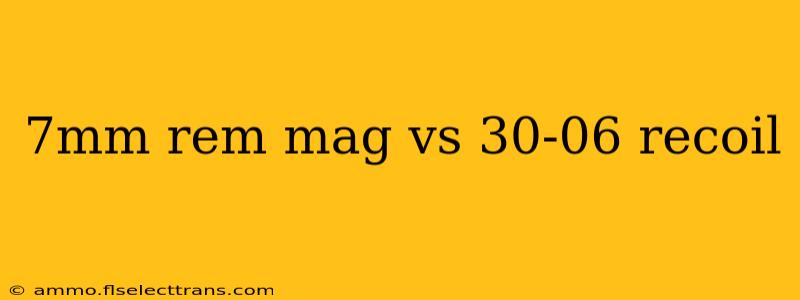Choosing between the 7mm Remington Magnum and the .30-06 Springfield often comes down to personal preference, but recoil is a significant factor for many shooters. This detailed comparison will analyze the recoil characteristics of both cartridges, helping you make an informed decision based on your shooting experience and tolerance.
Understanding Recoil: More Than Just a "Kick"
Recoil isn't simply about the "kick" you feel; it's a complex interplay of factors including bullet weight, powder charge, and the rifle's weight. While both the 7mm Rem Mag and .30-06 are powerful cartridges, their recoil profiles differ. We'll explore these differences using readily available data and focusing on factors that impact the shooter's experience.
Factors Affecting Perceived Recoil:
-
Free Recoil Energy: This measures the total energy transferred to the rifle upon firing. Higher free recoil energy generally translates to a more noticeable recoil impulse. While figures vary slightly depending on the specific ammunition used, the 7mm Rem Mag generally exhibits slightly less free recoil energy than the .30-06 when loaded with comparable bullet weights.
-
Recoil Impulse: This refers to the force of the recoil, how quickly the energy is transferred. A sharp, quick recoil impulse can feel more jarring than a smoother, slower one, even if the total energy is the same. The 7mm Rem Mag often exhibits a slightly sharper recoil impulse than the .30-06, which can contribute to a more perceived recoil despite lower energy.
-
Rifle Weight: A heavier rifle will absorb more recoil energy, resulting in a gentler felt recoil. The weight of the firearm plays a much larger role in managing recoil than the cartridge itself. A lightweight rifle chambered in either cartridge will produce a more substantial recoil than a heavier rifle of the same caliber.
-
Muzzle Brake/Compensator: These devices significantly reduce felt recoil by diverting propellant gases. Their use can dramatically alter the recoil experience for both cartridges, making them more manageable for a wider range of shooters.
7mm Rem Mag Recoil Characteristics:
The 7mm Rem Mag is known for its flat trajectory and excellent long-range performance. Its recoil, while substantial, is often described as manageable for experienced shooters. The slightly lower free recoil energy, combined with typically higher bullet velocities, can lead to a sharper, quicker recoil impulse. This can be less fatiguing during extended shooting sessions compared to the more drawn-out recoil of a heavier .30-06 round.
.30-06 Recoil Characteristics:
The .30-06 Springfield, a classic and versatile cartridge, offers a balance of power and accuracy. Its recoil is generally perceived as more substantial than the 7mm Rem Mag, particularly when using heavier bullets. The recoil impulse is often described as smoother and less abrupt than the 7mm Rem Mag. This can make the .30-06 feel more comfortable for some shooters, especially beginners, despite having higher free recoil energy.
The Verdict: It Depends
There's no single "winner" in this recoil comparison. The perceived recoil depends heavily on individual factors such as:
- Shooting experience: Experienced shooters often find both cartridges manageable.
- Rifle weight: A heavier rifle drastically reduces felt recoil for both cartridges.
- Ammunition choice: Bullet weight and powder load significantly influence recoil.
- Physical build and tolerance: Individual strength and sensitivity to recoil will vary.
Recommendation: The best approach is to rent or borrow rifles chambered in both cartridges and test them on the range. This allows for a direct comparison and helps determine which cartridge's recoil feels most comfortable and manageable for you. Consider using a recoil pad for increased comfort during your testing. Remember, a properly fitted rifle and good shooting technique are crucial for managing recoil regardless of the cartridge chosen.

